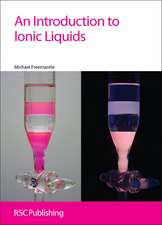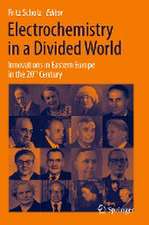Electrochemistry
Autor Carl H. Hamann, Andrew Hamnett, Wolf Vielstichen Limba Engleză Hardback – 22 feb 2007
Preț: 477.59 lei
Preț vechi: 536.62 lei
-11% Nou
Puncte Express: 716
Preț estimativ în valută:
91.40€ • 95.07$ • 75.45£
91.40€ • 95.07$ • 75.45£
Carte disponibilă
Livrare economică 22 martie-05 aprilie
Livrare express 11-15 martie pentru 58.53 lei
Preluare comenzi: 021 569.72.76
Specificații
ISBN-13: 9783527310692
ISBN-10: 352731069X
Pagini: 550
Ilustrații: 250 Abb., 35 Tabellen
Dimensiuni: 177 x 242 x 35 mm
Greutate: 1.12 kg
Ediția:2nd, Completely Revised and Updated Edition
Editura: Wiley Vch
Locul publicării:Weinheim, Germany
ISBN-10: 352731069X
Pagini: 550
Ilustrații: 250 Abb., 35 Tabellen
Dimensiuni: 177 x 242 x 35 mm
Greutate: 1.12 kg
Ediția:2nd, Completely Revised and Updated Edition
Editura: Wiley Vch
Locul publicării:Weinheim, Germany
Public țintă
Students in Chemistry, Lecturers in Chemistry, Students in Physics, Lecturers in Physics, Physical Chemists, Materials Scientists, LibrariesNotă biografică
Carl H. Hamann: Following his studies in mathematics, physics, biology and economics in Hamburg and Bonn, graduating in 1966 as a physicist, Carl H. Hamann gained his doctorate in 1970, becoming Professor for Applied Physical Chemistry at the University of Oldenburg in 1975. He has since concentrated mainly on fuel cells, electrochemical metrology, passage and adsorption kinetics, turbulent flows, the thermodynamics of irreversible systems, preparative electroorganic chemistry and technical electrochemistry. Professor Hamann has thus far published some 80 articles in journals and books. Wolf Vielstich: As Heinz Gerischer's first student, in Göttingen in 1952/53, Wolf Vielstich was concerned with developing a fast Potentiostaten while determining exchange current densities. Upon starting work at the Institute for Physical Chemistry, Bonn University, in 1960 he demonstrated that, apart from mercury, reproducible cyclic voltamograms, such as for the oxidation of hydrogen and methanol, are contained in solid electrodes, including Pt, Ir, Rh, Au and Pd. There then followed experiments with methanol/air and NiMH cells, among others. He was always interested in developing novel methods, such as the rotating ring electrode, on-line MS (DEMS), in-situ FTIRS and UHV analysis of adsorbants. Between 1986 and 1993, Wolf Vielstich was the Coordinator of the first European project to develop a DMFC, and in 1998 he was awarded the Faraday Medal by the Royal Chemical Society. Since 1999 he has been working as a guest of the Universidade de Sao Paulo, and edited Wiley's Handbook of Fuel Cells (2003). Professor Hamnett graduated from the University of Oxford with a BA (Chemistry) in 1970 and a D.Phil. (Chemistry) in 1973. He has held research and academic positions at the University of British Columbia, Canada, and at Oxford and Newcastle Universities, England, before his appointment in January 2001 as Principal and Vice-chancellor of the University of Strathclyde. He has nearly 200 publications in books and scientific journals, covering areas of spectroscopy, quantum theory and electrochemistry. His primary academic interests in recent years include the development and utilisation of spectro-electrochemical techniques in electrochemistry, and the development of improved fuel cells and solar-energy conversion devices.
Cuprins
Foundations, Definitions and Concepts Electrical Conductivity and Interionic Interactions Electrode Potentials and Double-Layer Structure at Phase Boundaries Electrical Potentials and Electrical Current Electrochemical Methods for the Study of the Electrode/Electrolyte Interface Reaction Mechanisms Industrial Electrochemical Processes Galvanic Cells Analytical Applications
















